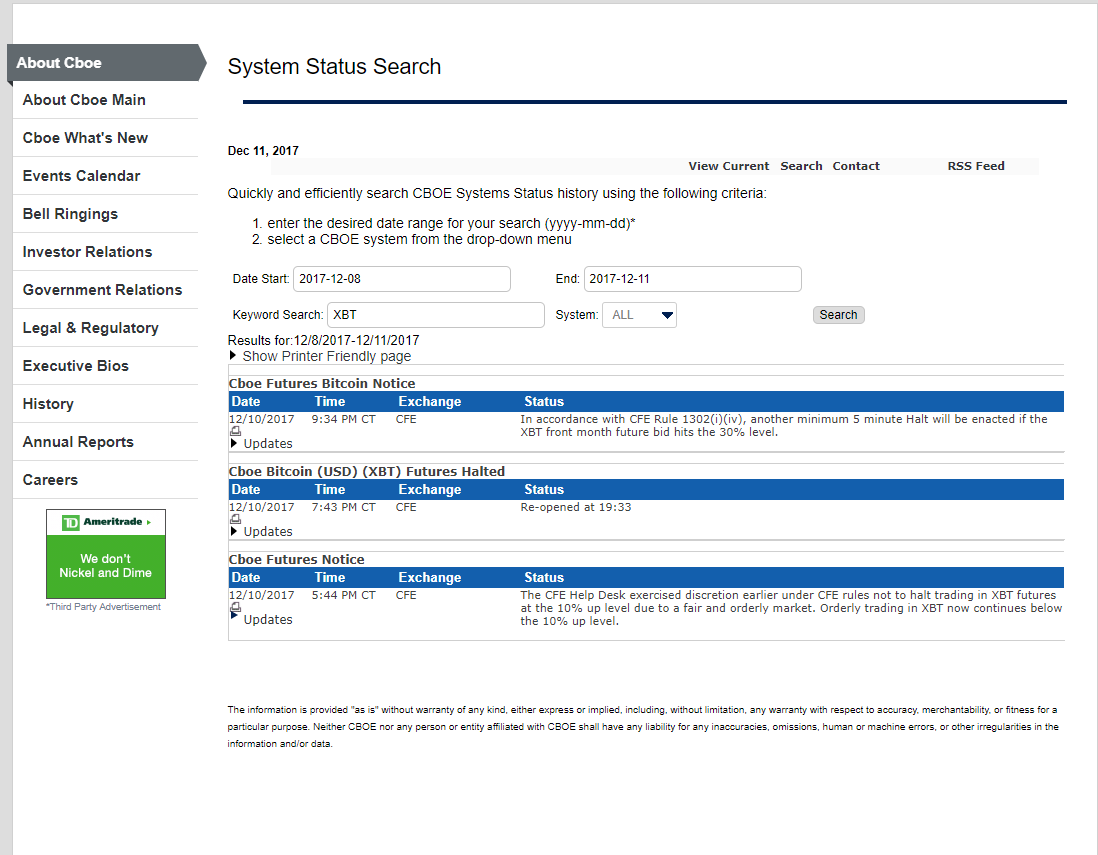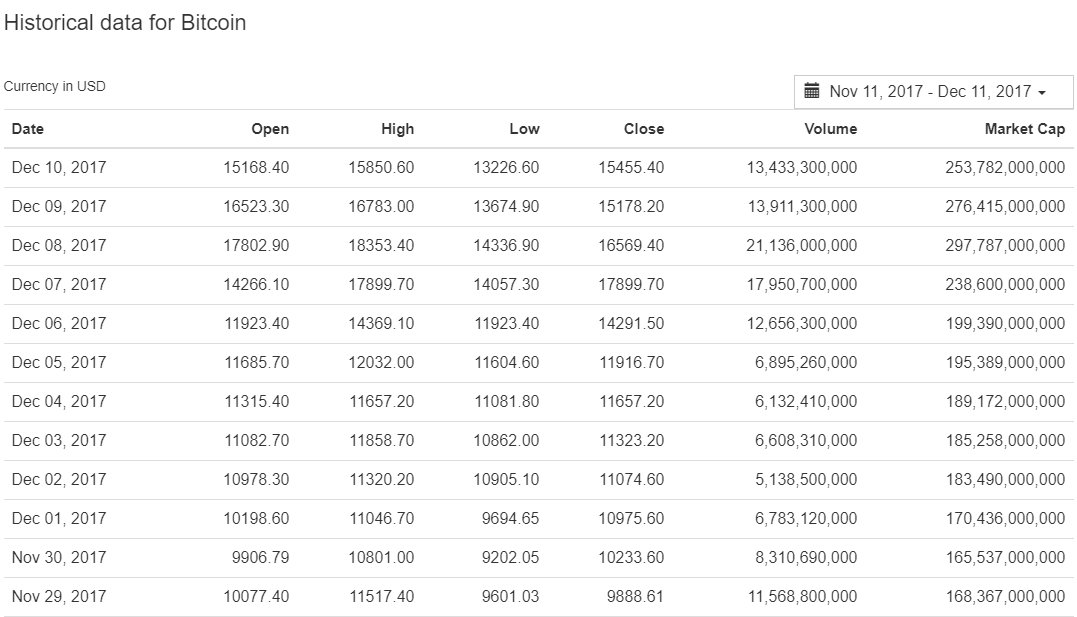Bitcoin Futures Are Here: The Story So Far

The week ahead will give better future indication of Bitcoin derivatives products as yesterday at 6 p.m. EST, the Chicago Board Options Exchange (CBOE) allowed bitcoin futures to begin trading under the symbol “XBT.” Chicago Mercantile Exchange (CME) is set to allow futures trading in the cryptocurrency of their own accord on December 18, 2017. Bitcoin futures were up over 20 percent leading into the U.S. market open. Current appetite for the futures contracts seems to show a stronger preference for near-term bitcoin futures priced above the current spot rate. According to the CBOE twitter feed, over 800 contracts were traded in the first two hours.

Image source: CBOE delayed quotes dashboard as of 3:53 PM. EST
At least one outage plagued the CBOE in early trading, including two minutes of downtime from 8:31 p.m. EST to 8:33 p.m. EST, while the CBOE stated at 11:34 p.m. EST that there would be a 5-minute hiatus if the front month (January expiration) rose above 30 percent.

Image Source: www.cboe.com
These deliberate halts in trading are known as “circuit breakers” and are meant to protect the market from unmanageable volatility.
While we wait to see how futures trading unfolds in the U.S. markets today, here are some of the notable events that got us into a world of bitcoin futures.
October 31
The CME Group gave bitcoin investors around the world a bit of a Halloween treat when they announced plans to allow bitcoin futures to be traded on their exchange. The Chicago Mercantile Exchange’s announcement notably coincided with the anniversary of the publication of Bitcoin inventor Satoshi Nakomoto’s original 2008 white paper on the cryptocurrency.
Cryptocurrency enthusiasts took this as a signal of mainstream acceptance of the asset class, and bitcoin closed the day (according to historical data provided by www.coinmarketcap.com) at $6,468.40. When futures trading opened last night, bitcoin was trading at $14,901.70.
December 1, 2017
Regulators gave bitcoin futures the green light for the CME Group as well as for self-certification by the CBOE Futures Exchange (CFE) as well as for the Cantor Exchange’s new contract for bitcoin binary options. The exchanges assured the CFTC that the new products were compliant with the self-certification process rules, and the CFTC refrained from halting the self-certification. CFTC Chairman J. Christopher Giancarlo stated in a press release:
Bitcoin, a virtual currency, is a commodity unlike any the Commission has dealt with in the past…[a]s a result, we have had extensive discussions with the exchanges regarding the proposed contracts, and CME, CFE and Cantor have agreed to significant enhancements to protect customers and maintain orderly markets.
December 4
The CBOE announced it would launch futures trading in bitcoin under the symbol “XBT” on Sunday night, December 10, 2017, at 6 p.m. EST. This move was seen as a manoever to beat the earlier announcement from the competing CME that they would allow futures trading in bitcoin beginning December 18, 2017. Not surprisingly, the CBOE’s usage of the exchange platform Gemini, owned by the Winklevoss twins, may allow the newly minted “Bitcoin Billionaires” to further capitalize on the successes of the cryptocurrencies.
December 5
A Natixis Investment Managers Survey of 500 global investors managing more than $19 trillion of assets has found that “nearly two-thirds [of survey participants] said Bitcoin was in a bubble, and this was a month before the cryptocurrency surged above $10,000 last week.”
Also bearish on bitcoin was Stephen Roach, a Yale University economist who told CNBC’s “The Rundown” that exchange legitimization makes bitcoin “somewhat dangerous [for investors],” citing a “lack of intrinsic underlying economic value to the concept.”
December 6
S3 Partners, a data research and analytics firm, sent this note to investors on GBTC ETF, the only ETF which trades bitcoin. In the note, Managing Director of Predictive Analytics at S3, Ihor Dusaniwsky, suggested that bitcoin as an asset would be “ripe for a pullback once the CBOE futures contracts go live” but also cautioned that the fees for shorting the GBTC ETF will be extremely high. While futures contracts would enable easier and safer access to both long and short positions, Dusaniwsky noted, futures trading would also carry premium costs for all GBTC ETF investors, stating:
Long GBTC holders may feel the pain of its 53% asset premium shrinking, while short sellers will probably be incurring a 50%+ stock borrow fee — both sides will be paying a premium in order to ride the Bitcoin rollercoaster once the CBOE futures start trading.
Also on December 6, 2017, trading volume for BTC nearly doubled from 6.9 billion to 12.7 billion and crosses the 10 billion volume threshold for the first time since Bitcoin crossed $10,000 (November 28, 2017). Whether this run up was related to the prospect of bitcoin futures or just normal market machinations is unclear.

Screenshot of historical data from Coinmarketcap.com (link above)
December 7
The Futures Industry Association, an industry organization whose primary members consist of the largest clearing houses and clearing firms for futures in the world, published an open letter it had sent to the CFTC chairman on December 6, 2017, decrying the lack of “a healthy dialogue between regulators, exchanges, clearing houses and the clearing firms who will be absorbing the risk of these volatile, emerging instruments during a default.” This is in spite of the fact that the letter also admits that, “Under law, exchanges may self-certify a product for trading by the close of business one day and then list the product for trading the next day.This process does not require CFTC approval or input…”
Also on December 7, in a joint interview with former Mayor Michael Bloomberg, Chairman and CEO of Goldman Sachs, Lloyd Blankfein, stated that, “We’ll [Goldman Sachs] see. If it works out and it gets more established and it trades like a store value and it doesn’t move up and down 20% and there’s liquidity in it, we’ll get to it.”
That same interview includes the suggestion that, according to an unnamed source with knowledge of Goldman Sachs plans, the investment bank plans to help clear bitcoin futures contracts for certain clients when the derivatives go live and that “the decision to clear client trades will be made on a case-by-case basis.” Goldman Sachs “will act in an agency capacity” and “won’t serve as a market-maker or build inventory in the derivatives.”
December 8
As the normal trading week came to an end, Coinbase and its exchange platform GDAX sent a reminder from Coinbase CEO, Brian Armstrong, to its users via blog and email to “invest responsibly,” also noting that “there may be downtime which can impact your ability to trade.” While seemingly innocuous, it appears the Coinbase team was preparing for a surge in trading volume that would crash its platform. At 10 p.m. on December 10, 2017, Coinbase tweeted that it would be offline for one hour of scheduled maintenance to “help to prevent slow performance and login issues during larger traffic surges.”
Conclusion
The market on Bitcoin Futures is open for business. After 14 hours of premarket bitcoin futures and a full day of trading from both European and U.S. investors, “XBT” seems to be functioning as planned. While spectators of the past week have foretold of everything from rosy outlooks to apocryphal warnings, we, at least for the moment, seem to be on a path toward embracing cryptocurrency futures as a new wave of derivatives.
The post Bitcoin Futures Are Here: The Story So Far appeared first on Bitcoin Magazine.


